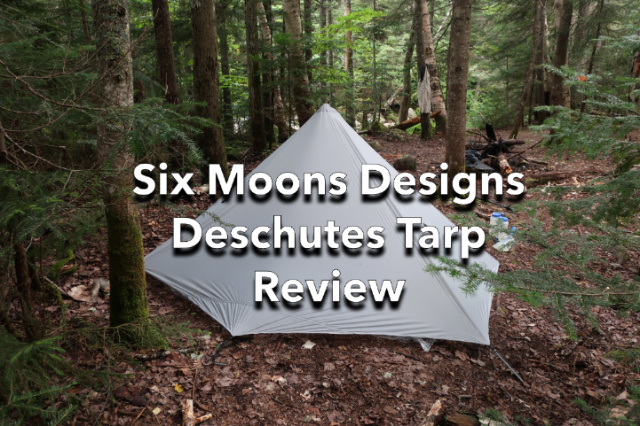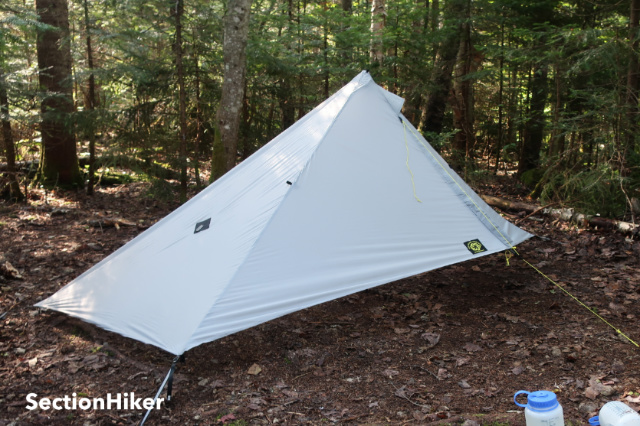
The Six Moon Designs Deschutes Tarp is a one-person, single-wall ultralight pyramid tarp which weighs 13 oz (although ours weighs 12 oz seam-sealed). Made with silnylon, this floorless tarp requires one trekking pole or tent pole to set up and six tent stakes. It has an enormous amount of internal space, 44 sq ft to be exact, although I wouldn’t recommend it for anyone over 6′ in height. You can also add insect netting and bathtub floor to it with the Six Moons Serenity Net Tent bringing the total weight up to 23 ounces.
Specs at a Glance
- Manufacturer’s Weight: 13 oz (not seam-sealed)
- Actual Weight: 12 oz, seam-sealed (tarp) 0.5 oz (stuff sack)
- Capacity: 1 person
- Type: Pyramid Tarp
- Pole: 45-49″, not included
- Stakes: Requires 6, not included
- Dimensions: 1o5″ (266cm ) max width x 80″ (203 cm) max depth
- Material: Silnylon w/ 3,000mm waterproof rating
The Six Moon Designs Deschutes Tarp has a six-sided pyramid shape that requires a single trekking pole adjusted to 49″ or tent pole (sold separately), to set up. The peak is offset from the middle towards the front of the shelter, which has two front doors split by a zipper. The two front doors are cut at a slight angle to create a covered front vestibule that does not reach the ground but has enough depth to prevent rain from splashing back at you.

I like this vestibule design because I like the connection to the outdoors and the increased airflow, but the Deschutes is decidedly not a full-coverage shelter with a rain fly that reaches to the ground unless you decrease the height of the pole, which is an option in bad weather.

If you want even more ventilation or views, you can also roll back both front doors, since the front guyline is attached to the peak and not the ends of the doors.

The Deschutes has 6 guylines located around the perimeter of the tarp. These are guyed out with reflective webbing lines and tensioners, but not linelocs and cordage used by other ultralight shelters. I haven’t noticed functional or performance differences in the webbing and hardware they use, although I prefer linelocs myself.

While there is a glove hook in the peak and plastic rings at the guy out points to attach a net tent, the Deschutes is a barebones tarp without any internal pockets or ceiling attachments, to suspend a bivy sack head net, for example. The lack of ceiling attachment points is puzzling since this is a standard feature included on all square, rectangular, and pyramid tarps. It’s a little thing, but it makes a huge difference in keeping the mosquito meeting off your face so you can sleep more comfortably.
If you need to deal with insects and you plan to use hang a three-season UL bivy sack for that, this isn’t the shelter to get. I find that disappointing because this tarp provides so much more coverage and weather protection than a flat or square tarp, with little added weight penalty.
Dimensions
While the inside of the Deschutes is huge, with 44 sq ft of surface area, the slope of the sidewalls reduces the amount of livable space where there’s enough headroom to sit up or even lie down. This is a problem with the majority of pyramid tarps, not just the Deschutes. On the Deschutes, you’ll find it better to store your gear at the rear of the tarp which has a lower ceiling than the front and is much more prone to internal condensation transfer.

The usable width of the Deschutes is also on the small side, due to the slope of the walls. While the specs say that the tent is 105″ / 266 cm wide, it feels quite cramped when lying inside at the widest point in a 6′ (72″) bivy sack with very little slack space at the head and foot ends to avoid touching the ceiling or even with sliding under the side walls. I’d recommend choosing a different shelter if you’re taller than 6′ in height. Six Moons Designs also recommends this.
Materials
The Deschutes Tarp is made with siliconized nylon (silnylon) with an excellent 3000 waterproof rating that exceeds that of most of the tents you can buy at REI. The front door closes with a YKK #3 zipper and is not water-resistant. It is covered with a silnylon flap to protect it from rain.
The Deschutes Tarp has to be seam-sealed, which is a bit of a hassle, but you can ask Six Moons to do it for you for a small fee. The rear-most four sides of the Deschutes are made with a single piece of fabric without any seams, which significantly reduces the amount of seam sealing required. The Deschutes packs up very small, 12″ X 4.5″, and doesn’t take up much space in a backpack. It is available in one color, grey.

Recommendation
The Six Moon Designs Deschutes Tarp is a bare-bones, one-person pyramid shelter that is lightweight and packs up small. It’s easy to pitch and provides good wind and weather protection by adjusting the height of the supporting pole. Pyramid tarps like the Deschutes offer a lot more protection than a flat or rectangular tarp and are a lot easier to use because they have a single standard configuration. The Deschutes is a solid option for backpackers under 6′ in height. If you need insect protection, I’d advise buying the companion Serenity Net Tent at the same time for insect protection.
If you want something lighter weight than a modular shelter system, I recommend trying the Deschutes Plus Ultralight Backpacking Tarp (16 oz) which has perimeter netting under the door and around the sides of the tarp. While you’ll still want to use a UL groundsheet, the perimeter netting eliminates the need for a separate bug bivy or bivy sack.
Six Moon Designs Deschutes Tarp
Comfort
Ease of Setup
Weather Resistance
Durabilty
Weight
Packed Size
Comparable Shelters
Zpacks Pocket Tarp w/ Doors

Mountain Laurel Designs Cricket

Updated: 2023.
Disclosure: Six Moon Designs donated this product for review.
SectionHiker is reader-supported. We only make money if you purchase a product through our affiliate links. Help us continue to test and write unsponsored and independent gear reviews, beginner FAQs, and free hiking guides. SectionHiker.com Backpacking Gear Reviews and FAQs
SectionHiker.com Backpacking Gear Reviews and FAQs
The Deschutes Plus is my go to shelter during bug season
It’s also easy to get in and out of
Cool. You really don’t see much use of insect skirts on shelters, but they are undoubtedly useful and effective.
Yep
The other Dan
Thanks for tis objective review. Very
If’n I wuz gonna camp with a pyramid type tarp it would be the Dyneema fly from my Tarptent Notch Li.
I have the Zpacks pocket tarp w/doors and the Six Moons Serenity tent fits nicely inside. A stick on loop attaches the netting to the back of the tarp for increased volume (added on) Total Wt: 15oz.
That’s the nice thing about Dyneema. A stick-on loop stays stuck. You can really achieve that with a silnyoln pyramid without sewing.
Will someone please tell me how you can use a floorless tent without having ants get in everything? I backpack in the Sierra which has these big black ants that will crawl everywhere, including in my ears at night.
Pack an anteater….what’s wrong with just packing a single wall or double wall tent?
Oh yes Phillip, my tent definitely has a floor! The big ants that got in my ears a couple times had snuck in. I am just making a sincere inquiry about how other backpackers tolerate the ants while sleeping under tarps, or cowboy camping.
Being a bivy user, I can’t imagine how a bivy sack would be any better. It’s just a net tent, but smaller.
Hi Katie. I also have had the ants try to join me in my shelter in the Sierra. I keep them out with my bivy zipped up. I have also used a spray of Picaridin around the perimeter of my shelter when the bugs are really thick and annoying….good luck
SectionHiker has good articles on bug bivies. I use a Tyvek ground sheet, sprayed with permethrin. (Also covered in SectionHiker.) You can wash the Tyvek to soften it up so it doesn’t make as much crinkling noise, but I use earplugs anyway. Not as protective as a tent, but it creates a partial barrier to creepy-crawlies. I don’t know how effective permethrin is against ants, since I’m more concerned by ticks. Some people sleep in a bug head net over their faces, but I find that annoying. You can also use a permethrin-treated sleeping bag liner. You might need to experiment to see what works best.
An alternative to the Descutes is the SMD Gatgewood Cape which also sets up as a pyramidal shelter. It provided roughly the same footprint (I think) and has a harness at the top which does provide a place to tether up my bivy cord. As it is also my rain poncho and pack cover I save additional weight. The cape weighs around 13 oz with the stakes.
I’ve had the Gatewood Cape for a while but I’ve not used it as I’ve managed to avoid rain, and I’ve not used it as a shelter because I normally sleep in a hammock. There’s a hike I like to do for a quick weekend getaway, and the last time I did the hike it dawned on me that there are more tent-able campsites along the trail than hammock-able ones. Thus, I’ve decided to do this hike several times as soon as the snow melts enough that I can get to the trailhead (probably July…). I’m hopeful that buy using the Gatewood Cape & the net tent on several trips I can get comfortable setting it up quickly.
Why do you think Ron hasn’t modified the deschutes to include a clip for a bivy? I love mine but agree, that simple addition would make a huge improvement with no weight penalty and seems like an easy change to make
Ron retired a few years ago and isn’t really involved with the business anymore. They’re mainly resting on their laurels these days. If you compare their new product output to other brands, it’s pretty marginal. They still make nice gear, but they’re strategically aimed at the lower, more price conscious end of the market and leverage their china manufacturing for maximizing profit. It’s not a bad business strategy actually given the increased focus on lightweight gear, but they have lost a lot of the “upstartedness” and innovation of a true cottage brand.